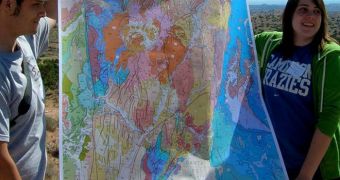Between 1.2 billion and 330 million years ago, the area near Santa Fe, New Mexico, was the site of a major asteroid impact. The conclusion belongs to a new study, which looked at an exposed mountain wall. The feature exposes a number of rock layers that look all the same to the eye of profane individuals, but which provide geologists with a wealth of data about Earth's distant past. It is estimated that the original impact crater was no less than between 6 and 13 kilometers in diameter, Space reports.
The reason why the timing of the impact cannot be determined with more accuracy is an anomaly known as the “Great Unconformity.” This means that the rock layers corresponding to the period stretching between 1.2-1.6 billion years and 330 million years ago are missing. This may have happened for a variety of reasons, but the leading theory is that a sea existed at this location a long time ago. This and other natural factors such as water receding, erosion, winds and so on, destroyed the rocks, which only began depositing ago when seas moved back on, 330 million years ago.
It was then that the first sediments were laid down again. This is why 1.2 billion year old layers of rock now lie directly underneath much newer ones. “We need an army of scientists and graduate students studying this site, over many, many years. It could take several lifetimes to do all the necessary work,” says University of New Mexico Institute of Meteoritics expert Horton Newsom. He conducted the work with colleagues Shawn Wright and Wolf Elston. He says that the team was amazed to learn that the rock layers are exposed directly.
This means that the team no longer needs digs in order to analyze the past events, just a lot of patience. “Such impact crater cross-sections are extremely rare in the world,” the expert says. He adds that the crater has long since been eroded entirely, but argues that additional studies of the site would help experts gain additional insights into how the impact affected the rocks underneath. The group will continue working in Santa Fe, with hopes that the actual size of the impact crater, as well as its age, will be accurately established.

 14 DAY TRIAL //
14 DAY TRIAL //